
- Home
- Memories
- Scrapbook ▽
- Topics ▽
- People ▽
- Events
- Photos
- Site Map
- Timeline
Page updated 7th February 2018
The first bombing on St Thomas, Exeter in the Second World War, was on 7th August 1940. It was an innocuous affair and reported thus:
"Five bombs fell on a south west town on Wednesday night. Little damage was done to property, and the only casualties were a middle aged man who was able to walk to a first aid post, a canary which died from shock and a few chickens." Express and Echo 9th August 1940.
Little did Exonians know, that within less than two years, they would be hit by a raid, that would take the heart out of their city.
After the first raid, the city suffered a further 18 raids, many just a single raider, but they still brought fear and some casualties to the population. In 1942, Hitler was enraged by the RAF's bombing of the ancient German cathedral city of Lubeck, on the night of 28/29 March 1942, targeted as a supply base for supplying the Russian front. Hitler decided to launch a series of reprisal raids on some of Englands most beautiful, but strategically, unimportant towns. He used the Baedeker tourist guide to select the targets and on 23rd and 25th April, Exeter was the first to be hit.
The first two raids in April were just a foretaste of what was to come. On the 23rd April, seven high explosive (HE) bombs fell west of the river in St Thomas and Marsh Barton with four fatalities. It was as though the pilots were getting their bearings. The second raid was at six minutes past midnight on the 25th when the alert was sounded again and parachute flares were dropped to guide the estimated 25 dive bombers to their targets. Large numbers of 1kg incendiary bombs interspersed with HE were dropped over Pennsylvania and other scattered parts of the city. This time, casualties were higher with 73 dead and 20 seriously injured. The next night a smaller raid accounted for another three dead. And this was merely the overture. Many of the citizens left the city and sheltered in the nearby villages, and even in the hedgerows, only to return a few days later.
The Luftwaffe then turned their attention to Bath, Norwich, York and Canterbury and when done, returned to Exeter on the night of the 4th May. This raid would change the city for ever.
A small raid in the early morning of the 3rd May was nothing unusual - a few fires and in the scheme of things, annoying but routine. There was nothing to suppose that the Luftwaffe would return in force.
At 01.36 the next morning, the 4th May, air raid 'red' was declared and the sirens sounded as 20 Luftwaffe bombers flew up the Exe estuary. The order to despatch the fire services was made. The first bombs fell in Newtown at 01.51, sticks of incendiaries designed to ignite and cause roof fires. Soon after, the Fire Barge that supplied No 6 line was sunk in the River Exe by a direct hit.
There were 19 reports of fires at 02.00 and by 02.15 fires were raging in the High Street, Sidwell Street and Fore Street - all available fire pumps were in action fighting to douse the rising inferno. At 02.19 the telephone system and lights failed. The High Street was blocked preventing access to the central area to fight the burning buildings. The fires were spreading from one building to another, despite the heroic efforts of the firewatch who would risk their lives to remove incendiary bombs from the rooftops with special scoops made for the job, before they could ignite and set further buildings on fire. In addition, the attacking planes would fly low, strafing the emergency personnel with machine gun fire.
At 02.30 the Telephone Exchange and the Gas Works down at Haven Banks were ablaze - the firefighters were drawing water from the many tanks that had previously been placed around the city, and from pumps at the River Exe. Air raid 'white' was declared at 02.50 as the German bombers turned and headed back to their bases in Northern France after 70 or so minutes of their deadly task.
Not all went to plan for the Luftwaffe during the raid. The Polish 307 Lwów Night-fighter squadron based at RAF Clyst Honiton (Exeter Airport) were scrambled and shot down five of the raiders. They only had four serviceable twin-engined Beaufighters equipped with radar, and it was like looking for a needle in the proverbial night sky.
"Exeter was the jewel of the West.... We have destroyed that jewel, and the Luftwaffe will return to finish the job"
"It was a night of terror for the Exeter people. When I approached this town the bright reflections guided me.
Over the town I saw whole streets of houses on fire, flames burst out of windows and doors, devouring the roofs.
People were running everywhere and firemen were frantically trying to deal with flames. It was a fantastic sight - no one who saw it will forget the greatness of the disaster.
We thought of the thousands of men, women and children, the victims of our deadly visit, but we thought of our Fuhrer and the command he gave 'Revenge'.
With cold calculation we carried out our orders."
For the firefighters, firewatchers, police, Home Guard and ambulance crews, it was far from over. The fires were spreading through the ancient, largely plaster and lath buildings, causing fronts to collapse into the road - in South Street, collapsing buildings ignited shops on the opposite side and many businesses went up in flames.
Reinforcement fire fighters left Taunton at 03.15, closely followed by units from Plymouth, while fire units were withdrawn from some low priority areas to fight blazes in more important places. Despatch riders were used to relay messages to Fire Force Headquarters - they rode to Kennford where a telephonist would communicate with headquarters at Yelverton. Reports were coming in of fires in the Southern Railway Goods Yard, a timber store at Mount Dinham and the Smythen Street, King Street area.
The Torquay reinforcements arrived at 05.00 to find a shortage of pumps and the water mains severely taxed. By 05.23 the area bounded by South Street, Market Street, Coombe Street and Fore Street containing the Lower Market were a conflagration. A south westerly high wind was causing problems spreading the flames, and sparks and burning embers were flying through the air, landing on roofs and yards.
The Control Centre located at the City Library in Castle Street was completely surrounded by flames and was abandoned at 05.29. The fire continuously spread, often from a single building to consume those on either side. Reports came in that the area from Denmark Road to St Leonards Road was ablaze, while 850 ft of hose had to be laid to Magdalen Road. More hose was run to Cathedral Close as the fire spread from the Bedford Circus area into the back of the cottages lining the Close. Gradually, the fire fighters started to bring the burning buildings under control although there were areas that were still an inferno. At 06.50 a call went out to save the Telephone Exchange below the Control Centre, while 1,750 ft of hose was laid to tackle the inferno at the junction of Fore Street and Market Street.
At 07.18 the Divisional Fire Officer reported:
"situation well in hand, everything working satisfactorily - no need for alarm. Prepare to feed and relieve personnel on fire ground".
However, the message was premature as fires spread along Clifton Road, Summerland Street and Gladstone Road. The swimming baths were used to supplement the water supply in that area. Paris Street, Summerland Street and Belgrave Road were well alight and there was a danger from falling masonry and intense heat in the narrow streets.
By 07.42 many roads had been closed to facilitate the fire fighters, and the fires were now being brought under control in the York Road area. There were also an estimated 39 unexploded HE bombs to add to the hazards faced by the rescue crews.
Gradually, through the morning, as the fires were doused, fire crews returned from their tasks throughout the city and mobile units were formed to catch small, sporadic blazes before they had a chance to spread. Through the late morning and early afternoon reports came into the relocated Control Centre that Blackboy Road, Paris Street, St Lukes College and Dix's Field were extinguished and other areas were being dampened down. Several canteens were opened across the city to feed the many personnel involved in the operation and Heles School was requisitioned as a feeding centre. A field kitchen was opened on Bury Meadow for women and children.
Just when the fire service thought that the fires were abating, at 17.26 a call went out from Column Officer Lyne, based in Cathedral Close,
"send Turntable Ladder immediately to Colsons - relay will be available on arrival".
The bomb damaged premises around Colsons had succumbed to the flames and the fire spread into the top floor and roof of the store. The rest of the building was only saved by the timely action of the fire services and a 4ft 6in cob wall that held the flames back.
Throughout the rest of the day and night and into the 5th May there continued to be outbreaks including St Stephen's Church, Gandy Street, and St Mary Arches Church. It wasn't until 12.30 on the 7th May that all reinforcements were stood down - 195 Reinforcing Pumps and 1,080 personnel were used during the raid and aftermath to fight the many fires.
The raid of the 4th May killed 156 and injured 563, many seriously. Thirty acres of the city were destroyed and many ancient buildings damaged or consumed in the flames. The Cathedral, was hit by one bomb that destroyed St James Chapel and removed two buttresses - luckily, in 1940, the stained glass had been removed to safety. Deller's Cafe, Bedford Circus, St Lawrence Church, the Lower Market, the Globe Hotel, Dix's Field, the College of the Vicars Choral and many more historic buildings were lost. The City Library which had served as the Control Centre was burnt out and about a million books and historic documents went up in smoke. Two thirds of the High Street were destroyed and many houses in the Newtown area.
It was in 1945 that Thomas Sharp published his Exeter Phoenix plan on the rebuilding of the city. Many of his ideas were tentative, and some of the best only partly realised due to a lack of money and a lack of courage, but after twenty years most of the damaged areas had been rebuilt. Princesshay is probably the most prominent legacy of the night of the 4th May 1942 and ironically, 63 years after the awful night it was torn down and redeveloped.
In 19 raids on Exeter, 265 were killed and 111 seriously injured while 677 were injured to a lesser extent. Many of the dead were buried in a mass grave in Higher Cemetery. Also see the list of Exeter's bombing dead.
A large part of the shopping area was destroyed and many houses. Replacing the damaged city took 20 years for the main areas as a completely new infrastructure had to be installed - post war Britain was a different place and the citizens of Exeter like other war ravaged places expected more than they had pre-war.
400 shops, nearly 150 offices, over 50 warehouses, and stores, 36 clubs and pubs.
Of 20,000 houses in the city, 1,500 were destroyed, 2,700 seriously damaged and the majority of the remaining 16,000 sustained some slight damage.
Sources - Exeter Burning by Peter Thomas, Exeter, the Blitz and Rebirth of the City by Norman Venning, Exeter Blitz, A Souvenir Account, Devon Learning Resources, Express & Echo, Brian Slemming, Exeter Phoenix by Thomas Sharp, Allan H Mazonowicz © 2005/7 David Cornforth - not to be used without permission. The Forgotteh Few by Adam Zamoyski.
Also see:
Scrapbook
1940's
Blitz Poem
Memories of the war
The Blitz in photographs
UXB defusing
Gillard Broadcast
Frank Gillard's BBC broadcast after the Exeter blitz. New
 Film of the blitz
Film of the blitz
Damage to the Cathedral & Churches
Damage to the City and the Clear Up
The City Recovers and Public
Information
Bury Meadow and Heles School
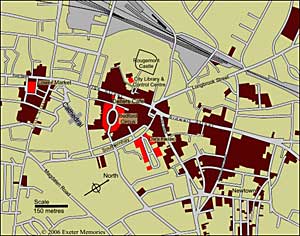 Map
of damage from the Exeter blitz. ©2006 Exeter Memories.
Map
of damage from the Exeter blitz. ©2006 Exeter Memories.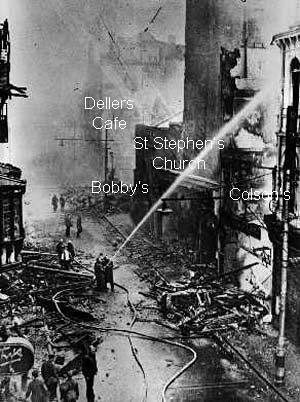 Firefighters in the High Street, fighting the blaze at Colsons. Courtesy
&Echo
Firefighters in the High Street, fighting the blaze at Colsons. Courtesy
&Echo
My family
moved to Exeter in early 1940 as my father was appointed as Minister of
the Elim Pentecostal Church on Paris street. During that major three
day Blitz Paris street was particularly hard hit. The Elim church was a
large solid stone building, which the fire services decided to use as a
firebreak. Water was continually played on the building. As a
consequence homes on lower side of Paris street were largely saved from
destruction. Those on the upper side of the street were totally
destroyed. The church received some heavy water damage, but as I recall
not a service was missed.
Brian Slemming
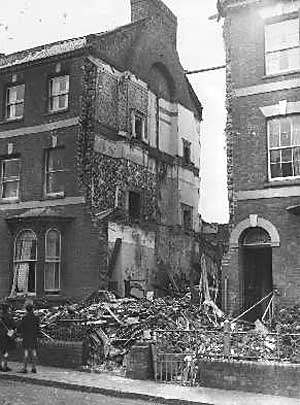 Damaged
house after the 4th May raid Courtesy Express & Echo
Damaged
house after the 4th May raid Courtesy Express & Echo
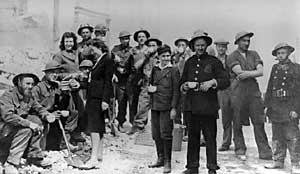 Rescue workers taking some rest after
the raid Courtesy Express & Echo
Rescue workers taking some rest after
the raid Courtesy Express & Echo
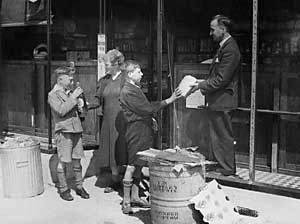 Boys being handed rations after the
Exeter blitz Courtesy Express & Echo
Boys being handed rations after the
Exeter blitz Courtesy Express & Echo
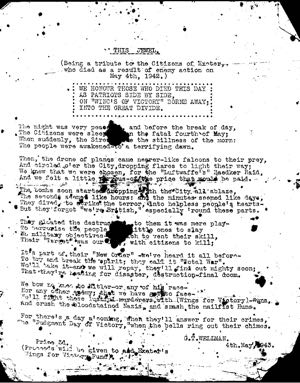 The above poem was privately
printed, and sold for 3d a copy on the first anniversary of the May 1942 bombing. The proceeds were given to the City's 'Wings for Victory' fund.
The above poem was privately
printed, and sold for 3d a copy on the first anniversary of the May 1942 bombing. The proceeds were given to the City's 'Wings for Victory' fund.
Full text of the poem. Used with the kind permission of Allan H Mazonowicz
│ Top of Page │